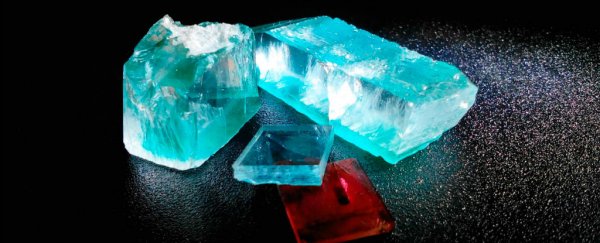For the first time, Russian physicists have managed to effectively 'dissolve' water in an emerald, by overriding the hydrogen bonds that usually hold water molecules together.
Without the influence of these hydrogen bonds, the water molecules aligned themselves according to the interaction of their positively and negatively charged poles - or dipoles - which is something researchers have been trying to do for years, but have never managed to achieve.
It's a little weird to wrap your head around, but just like a sugar cube dissolves in water because its molecules are becoming incorporated into the liquid, in this experiment, the water itself has become incorporated into the tiny cages of the emerald, rather than pooling together.
The reason this is so cool is because this particular property of water - known as ferroelectricity - had been predicted by numerous computer models, but had never been experimentally demonstrated before.
Now that researchers from the Moscow Institute of Physics and Technology have achieved this in the lab, they can use the 'dissolved' water to better understand other mysterious phenomena observed in nature, and the find also lead to more efficient materials.
It's even thought that this elusive behaviour of water molecules, and the tiny electric fields it generates, could be crucial within our own cells.
"The ferroelectricity of water molecules may play a key role in the functioning of biological systems and find applications in fuel and memory cells, light emitters and other nanoscale electronic devices," the researchers write in Nature Communications.
Let's step back a second here though, because to understand why the discovery is so exciting, you need to know a bit about the nature of water.
H2O, as most of us are aware, is made up of two hydrogen atoms and one oxygen atom, and looks (in theory, at least) a little like this:
The two hydrogen atoms are slightly positively charged, and the oxygen atom is slightly negatively charged, and this makes water molecules dipoles.
Because water molecules have such strong pull from the negatively charged pole - known as its electric dipole moment - in solid-state physics, you'd expect them to display something called ferroelectricity, which basically means that when a material cools down, all the dipoles will align themselves in an ordered pattern. (It's like ferromagnetism, but with electrical charge.)
But in liquid water, that ferroelectric alignment doesn't occur, because the molecules are located so closely together that they're dominated by short-range hydrogen bonds.
Those hydrogen bonds form because the negatively charged oxygen atom of one molecule wants to bond with the positively charged hydrogen of another molecule - and this keeps water molecules constantly disorganised and fluid, and overrides the long-range dipole-dipole forces.
To overcome this, the Russian team decided to try to separate the water molecules just enough so hydrogen bonding no longer kicked in. They did this by taking an emerald, and trapping the water molecules within nanoscale cavities in its crystal structure.
This kept the molecules far enough apart that it diminished the hydrogen bonding, but still close enough together for dipole-dipole forces to have effect.
When they did this, the researchers were able to detect for the first time ever that liquid water was displaying ferroelectricity - and all its dipole moments were arranging in an ordered pattern.
"Our team has succeeded in placing water molecules under conditions allowing us to obtain the first-ever reliable observations of the alignment of molecular dipoles of water," said lead researcher, Boris Gorshunov.
You can see that represented in the diagram below, where the red arrows represent the dipole moments, or the 'pull' of electrons from the positively to the negatively charged pole. The green structures are the nanocages within the emerald:
 Moscow Institute of Physics and Technology
Moscow Institute of Physics and Technology
"As for possible practical applications, their scope could be fairly wide," explained Gorshunov.
"It should be noted that the researchers now have the opportunity to study this phenomenon under the influence of various external factors … and thus advance our understanding of this phenomenon and its role in various systems, including living organisms."
This is some pretty intense physics, but it's also a really big moment for our understanding of how water - one of the building blocks of life - functions, and the strange properties it has under certain circumstances.
We can't wait to see what the team discovers from this experiment.
The research has been published in Nature Communications.

